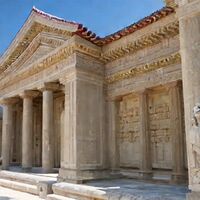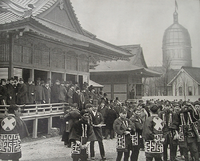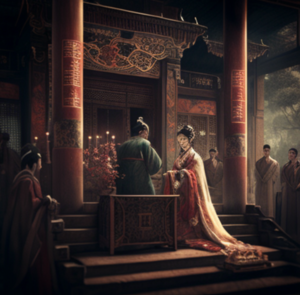Tianchaodao

Imperial Heavenly Cult | ||||

Entrance to the Temple of Heavenly Light, a temple in Shiro-Jingdaoese style in Shirekeep: From the 1710's the typical Jingdaoese architecture was mixed with Apollontean and Shirerithian aspects during the Salomeid Revival. | ||||
| Theology: | Polytheism
Part of Cedrism | |||
| Origin: | 1642 AN (as state religion of Jingdao) | |||
| Countries: |
| |||
Tianchaodao, meaning "The Way of the Empire" in the Jingdaoese language, was the state religion of the Great Jing between 1642 AN and 1704 AN. These days it's also known as the Imperial Heavenly Cult or Wanderers of the Pure Path. It was not a 'religion' in the normal sense of the word, as it was more an ideological set of beliefs to strengthen the ties and loyalties of the Empire's subjects to the Heavenly Throne. It acts as the dominant Cedrist cult and Temple within Greater Kildare, succesfully retaining its dominant position in the eastern part of the Shirerithian Empire and spreading its influence westwards.
With the Salomeid Revival, and the donation of the Heavenly Mandate by the Xinshi Emperor to Kaiseress Salome, a series of reforms were introduced to align the Faith with Cedrism.
The Tianchaodao is based on the belief that there is multiple deities who created and oversees the world. Several of these deities are believed to have a personal interest in the well-being of the Shirerithian people, and are responsible for bestowing blessings and rewards on those who obey its laws and commandments.
It also teaches that the Cedrist Gods have a special interest in the Imperial Republic, and that it has appointed the Kaiseress as its representative on earth. She is aided in her mission by the Heavenly Light, who guides the Kaiseress on the Path to Ascendance to Divine Godhood. As the earthly representative the Kaiseress is responsible for ensuring that the laws and commandments of the deity are followed, and that the Shirerithian people are protected and prosperous. Failure to do so may result in punishment from the Heavenly Temple, including loss of blessings, rewards, and even one's life.
Origins
It was originally an offspring of Catologism. The main teaching of Tianchaodao was complete submission to the divine Heavenly Light, as it was the only road to salvation and the only way to serve the Gods. The Way of the Empire did not dispute that there were other Gods than the Heavenly Light, but did not allow the Jingdaoese people to worship them, instead the people should worship the Heavenly Light.
The faith went into a crisis, when - after the death of the Chidao Emperor - his successor refused to take up Her role as worldly leader.
It kept its status as de facto state religion within the Great Apollonian Empire and while the Jingdaoese Community was replaced by the Democratic Apollonian Republic of Kildare. Eventually, in 1707 AN, the Xinshi Emperor announced Her intention to reform the religion, so it could aid in strengthening ties between the western and eastern parts of the Imperial Republic.
Alriggian variant of the Tianchaodao
Many people of Jingdaoese descent in Alrig are followers of the Tianchaodao. This variant of the Tianchaodao differs from the variant in Jingdao because complete submission to the Heavenly Light is not asked, only that all prayers and all devotion is directed towards him. The worship of the Heavenly Light is not controversial in Alrig, but ties in with the local practice. In Alrig followers of the various religions only publicly refer to their God as "the Lord", followers of the Tianchaodao are no exceptions.
Organization
Heavenly Light
The hierarchy of the Tianchaodao is headed by the Heavenly Light. He or She embodies the living reincarnation of one of the gods, and acts as living guide for the Ordinary mortals. During the 16th and 17th century, the institutions of the cult were heavily entangled with those of the Jingdaoese State. With the integration of Jingdao into the Imperial Republic of Shireroth, those institutions were reformed to stand on their own.
Gong Tianting
The Gong Tianting (Heavenly Council) is the most important council within the Tianchaodao. It consists of the most important shrine and temple priests, whom are in charge of the ecclesiastical provinces.
Orders
There are a number of Orders within the Tianchaodao, whom follow the central tenets.
- Seishin Order
- Order of the Siseranists
- The Tegong, acts as semi-independent paramilitary organisation and defends the Faith.
Central tenets
The cult may claim to be a religion, but it is often experienced as a way of life. Allegiance to the basic foundations of the State, portrayed by the Heavenly Light and the Kaiseress, are inextricably linked to the cult. The Tianchaodao has little to no problem taking on new gods. Her rapid adoption of the Cedrist pantheon in the early 18th century testified to this.
The Tianchaodao, has some central tenets:
- The Heavenly Light acts as highest religious leader and guide towards Eternal Bliss and Redemption. He is a central and necessary figure in reaching the Afterlife.
- The Heavenly Lights are reincarnations of gods, like Sisera.
- They act as Guide towards the Pure Path.
- The Heavenly Light - in His wisdom - recognizes the necessity of a strong, worldly leader to guide the through life on Micras. A Heavenly Mandate is granted - for life - to the Kaiser(ess) of Shireroth.
- The Kaiser of Shireroth acts is seen as the leading figure in earthly affairs, without whom the Imperial Republic and Micras would fall in despair.
- Shrines and temples are in possession of a portrait of picture of both the Heavenly Light and Kaiser(ess). These are placed in a ho an den (a small shrine, often located in or next to a larger temple of shrine, which acts as inner sanctum). Those pictures need to be placed at the same height, as they both represent two sides of the same coin: the Path to a Better Life. During ceremonies (weddings, funerals,...), the portrait of the Heavenly Light is placed one step higher, as the Heavenly Light acts as a guide in the Search for a better life.
Ceremonial rites
Prayer ceremonies and Temple visits

Temple and shrine visits are a common part of the daily life of a follower of Tiachaodao. During the daily prayer ceremony it's tradition to pray for the well-being of the Imperial Republic and its religious and earthly leadership. Most believers turn to the Kaiseress and Heavenly Light in their prayers. After all, they represent the Faith, so that specific supplications to the countless gods are not necessary. Those who want to deal with a god in more depth, or simply have a specific question or problem, then turn to that specific deity. However, such prayers usually do not take place during the daily prayer ceremonies, but separately and in a more modest circle.
The Prayer Ceremony is integrated into the school curriculum, and every school in Greater Kildare has at least one ho an den (a special shrine with the pictures of the Heavenly Light and the Kaiseress). Since 1716 AN, the Mango-Strengthening Movement (under pressure of Jing nobility) has pushed for the creation of ho an den's and implementation of Tianchaodao in all Shirerithian schools.
One of the used prayers:
Almighty Gods,
We give You thanks for the Heavenly Mandate of our Kaiseress, who provides earthly protection of the Faith and its Followers.
May She find Godhood and eternal enlighthment on Her Path.
We give You thanks for the guiding hand of our Heavenly Light.
Blessed is She who guides us along the Pure Path to salvation.
May They ever be faithful servants of the will of the Celestial Temple and a beacon of hope to all who look to her for guidance.
We ask that You continue to bless her with Your wisdom and strength, and keep Them safe from all harm.
Grant Them the grace to lead Your people in righteousness and peace, and bring us all ever closer to the salvation.
Baptism
Marriage

A wedding ceremony traditionally has eight parts:
- Processional. The processional begins with bridesmaids and groomsmen walking down the aisle, typically paired up.
- First bow towards the ho an den (which houses the painting of the Kaiser and HL).
- Readings. A few people may be invited up to share or exchange readings at this point in the ceremony. ...
- Exchange of Vows.
- Second bow towards the ho an den.
- Pronouncement of Marriage.
- The couple drinks from a bowl of wine or beer, symbolizing the fertility of the Shirerithian lands.
- Third bow towards the ho an den, followed by procrastination and eight cheers for the Kaiser, the Heavenly Light, the Imperial Republic and the new couple.
Divorce is accepted among the followers of the Cult.
